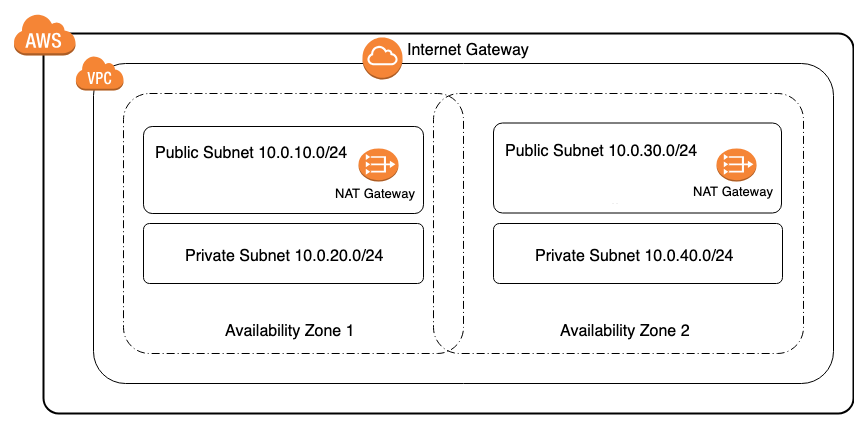author: Phil Chen
This AWS CloudFormation solution creates a AWS VPC with 2 public subnets and 2 private subnets leveraging two availbility zones. All appropriate outbound routing for public subnets use an AWS Internet Gateway and private subnets use a AWS NAT Gateway. For security and compliance ensuring your resources are appropriately separated between public and private network environments and spread across multiple AWS availability zones is a necessity.

AWS CloudFormation provides a common language for you to describe and provision all the infrastructure resources in your cloud environment.
Amazon Virtual Private Cloud (Amazon VPC) lets you provision a logically isolated section of the AWS Cloud where you can launch AWS resources in a virtual network that you define.
AWS Resource Costs
As with most AWS services you will incur costs for usage. For this CloudFormation template the resources that incur costs are as follows.
-
Pricing:
- NAT Gateway pricing resource used in example: 2 Nat Gateway's
- Elastic IP pricing resource used in example: 2 Elastic IP's
Prerequisites
- Amazon Web Services Account
- IAM user with the following permissions:
- AWSCloudFormationReadOnlyAccess
- AmazonVPCFullAccess
- AmazonEC2FullAccess
CloudFormation Template
- The CloudFormation Template is available on GitHub:
Deploy the CloudFormation Template
-
AWS Management Console
- Login to AWS Management Console
- Launch under CloudFormation your 2-zone-vpc-cf-template.yml (included in this repo)
-
CloudFormation Fields:
- Stack name (Enter a name to associate to your AWS VPC deployment)
- Environment Name (Name to describe the VPC environment) Next
- Continue choosing Next
- Click Create (This will take a few minutes for resources to be created)
Results of the CloudFormation Template
In the AWS Management Console you should be able to verify the following have been created.
- Resources Created:
- 1 Public Subnet 10.0.10.0/24 (in Zone A, with 254 usable IP's)
- 1 Private Subnet 10.0.20.0/24 (in Zone A, with 254 usable IP's)
- 1 Public Subnet 10.0.30.0/24 (in Zone B, with 254 usable IP's)
- 1 Private Subnet 10.0.40.0/24 (in Zone B, with 254 usable IP's)
- 5 Route table entries to route traffic either within 10.0.0.0/16 or to the either the Internet Gateway or NAT Gateway for outbound
- 1 Internet Gateway (for all outbound traffic)
- 2 NAT Gateways (for outbound traffic from private zone A and B)
- 2 Elastic IP addresses (associated to respective NAT Gateway's)